2009 JEEP GRAND CHEROKEE traction control
[x] Cancel search: traction controlPage 306 of 521

Hill Climbing
NOTE:Before attempting to climb a hill, determine the
conditions at the crest and/or on the other side.
Before climbing a steep hill,shift the transmission to a
lower gear and shift the transfer case to 4WD LOW. Use
first gear and 4WD LOW for very steep hills.
If you stall or begin to lose forward motionwhile
climbing a steep hill, allow your vehicle to come to a stop
and immediately apply the brakes. Restart the engine,
and shift into REVERSE. Back slowly down the hill,
allowing the compression braking of the engine to help
regulate your speed. If the brakes are required to control
vehicle speed, apply them lightly and avoid locking or
skidding the tires.
WARNING!
If the engine stalls, you lose forward motion, or
cannot make it to the top of a steep hill or grade,
never attempt to turn around. To do so may result in
tipping and rolling the vehicle. Always back care-
fully straight down a hill in REVERSE gear. Never
back down a hill in NEUTRAL using only the brake.
Remember, never drive diagonally across a hill always
drive straight up or down.
If the wheels start to slip as you approach the crest of a
hill, ease off the accelerator and maintain forward motion
by turning the front wheels slowly. This may provide a
fresh “bite” into the surface and will usually provide
traction to complete the climb.
304 STARTING AND OPERATING
Page 307 of 521
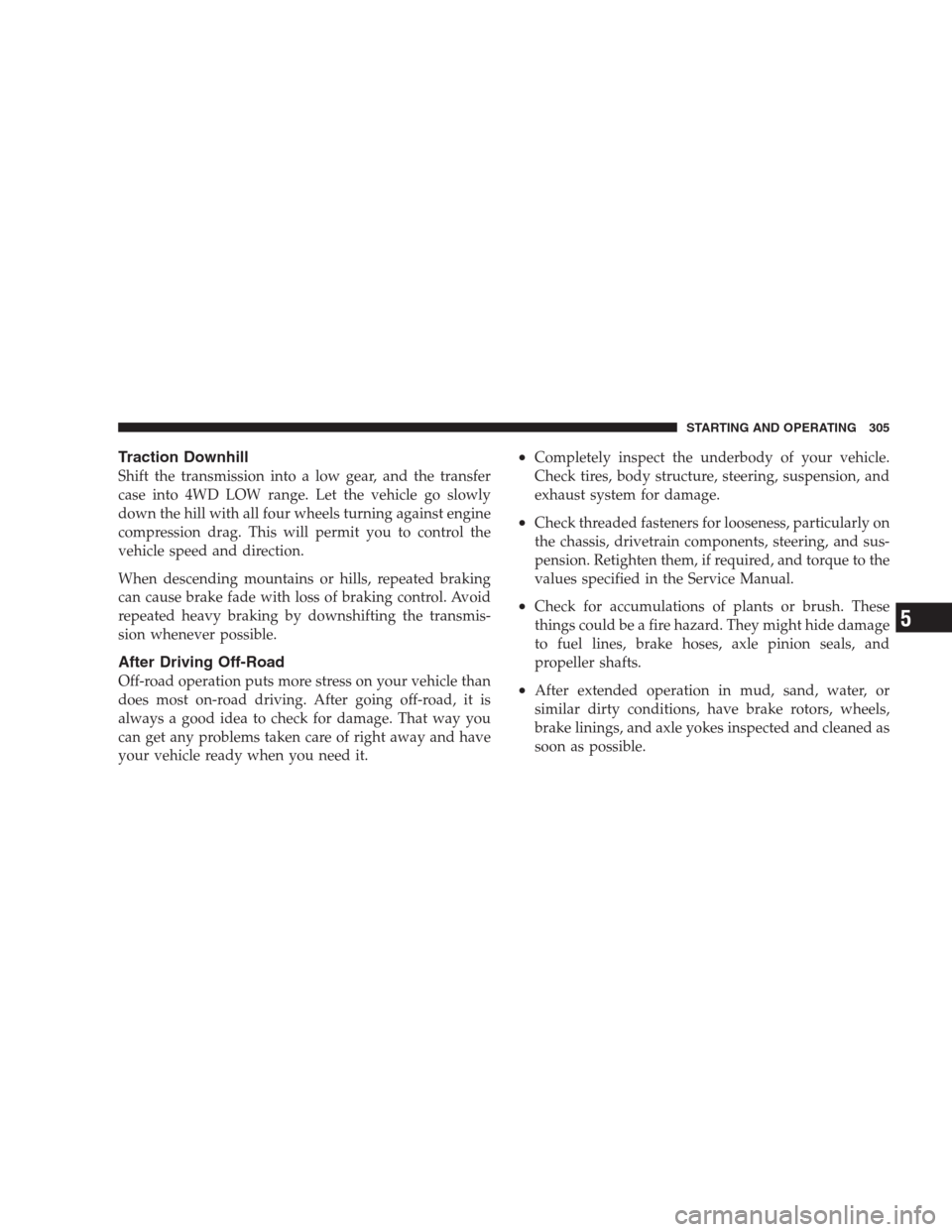
Traction Downhill
Shift the transmission into a low gear, and the transfer
case into 4WD LOW range. Let the vehicle go slowly
down the hill with all four wheels turning against engine
compression drag. This will permit you to control the
vehicle speed and direction.
When descending mountains or hills, repeated braking
can cause brake fade with loss of braking control. Avoid
repeated heavy braking by downshifting the transmis-
sion whenever possible.
After Driving Off-Road
Off-road operation puts more stress on your vehicle than
does most on-road driving. After going off-road, it is
always a good idea to check for damage. That way you
can get any problems taken care of right away and have
your vehicle ready when you need it.
•Completely inspect the underbody of your vehicle.
Check tires, body structure, steering, suspension, and
exhaust system for damage.
•Check threaded fasteners for looseness, particularly on
the chassis, drivetrain components, steering, and sus-
pension. Retighten them, if required, and torque to the
values specified in the Service Manual.
•Check for accumulations of plants or brush. These
things could be a fire hazard. They might hide damage
to fuel lines, brake hoses, axle pinion seals, and
propeller shafts.
•After extended operation in mud, sand, water, or
similar dirty conditions, have brake rotors, wheels,
brake linings, and axle yokes inspected and cleaned as
soon as possible.
STARTING AND OPERATING 305
5
Page 314 of 521
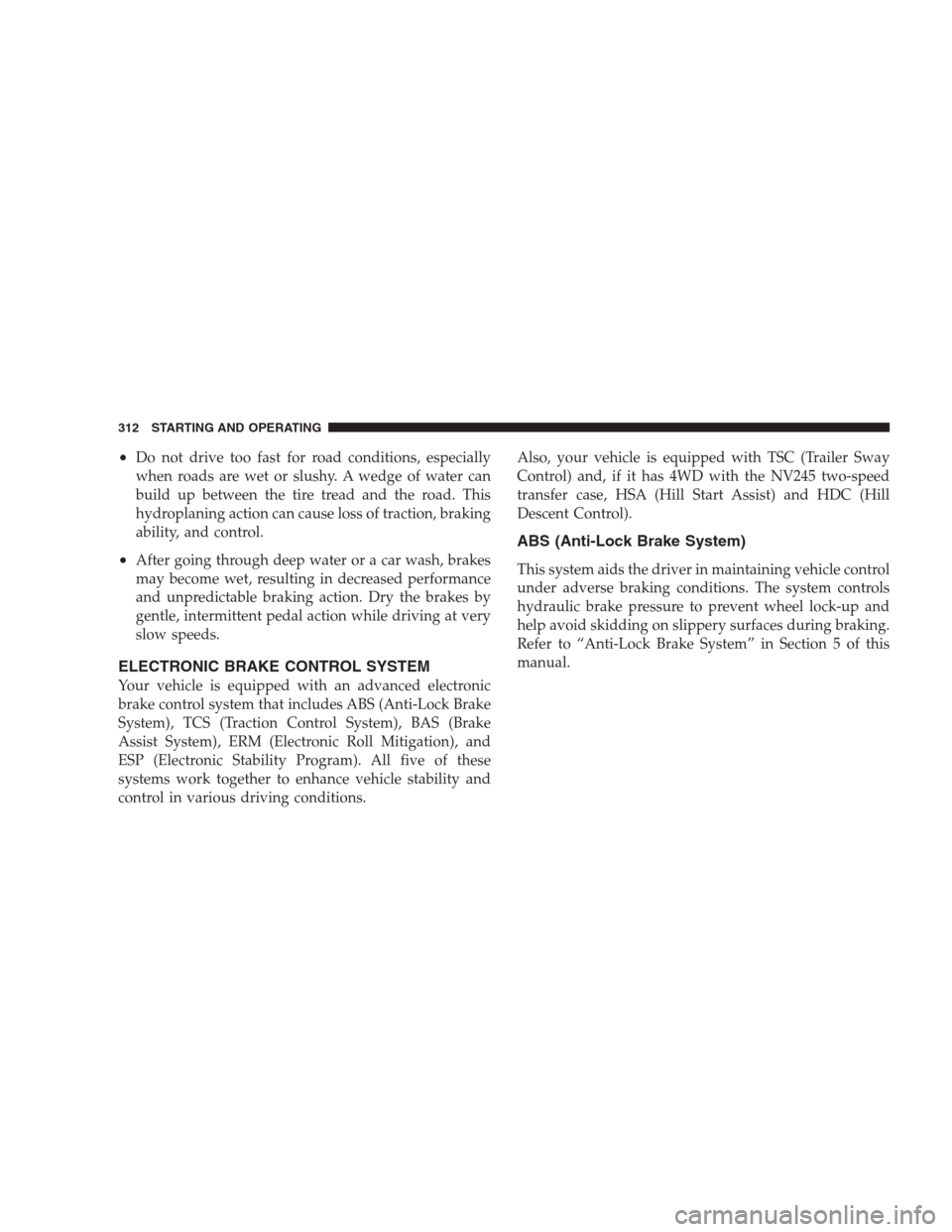
•Do not drive too fast for road conditions, especially
when roads are wet or slushy. A wedge of water can
build up between the tire tread and the road. This
hydroplaning action can cause loss of traction, braking
ability, and control.
•After going through deep water or a car wash, brakes
may become wet, resulting in decreased performance
and unpredictable braking action. Dry the brakes by
gentle, intermittent pedal action while driving at very
slow speeds.
ELECTRONIC BRAKE CONTROL SYSTEM
Your vehicle is equipped with an advanced electronic
brake control system that includes ABS (Anti-Lock Brake
System), TCS (Traction Control System), BAS (Brake
Assist System), ERM (Electronic Roll Mitigation), and
ESP (Electronic Stability Program). All five of these
systems work together to enhance vehicle stability and
control in various driving conditions.Also, your vehicle is equipped with TSC (Trailer Sway
Control) and, if it has 4WD with the NV245 two-speed
transfer case, HSA (Hill Start Assist) and HDC (Hill
Descent Control).
ABS (Anti-Lock Brake System)
This system aids the driver in maintaining vehicle control
under adverse braking conditions. The system controls
hydraulic brake pressure to prevent wheel lock-up and
help avoid skidding on slippery surfaces during braking.
Refer to “Anti-Lock Brake System” in Section 5 of this
manual.
312 STARTING AND OPERATING
Page 315 of 521
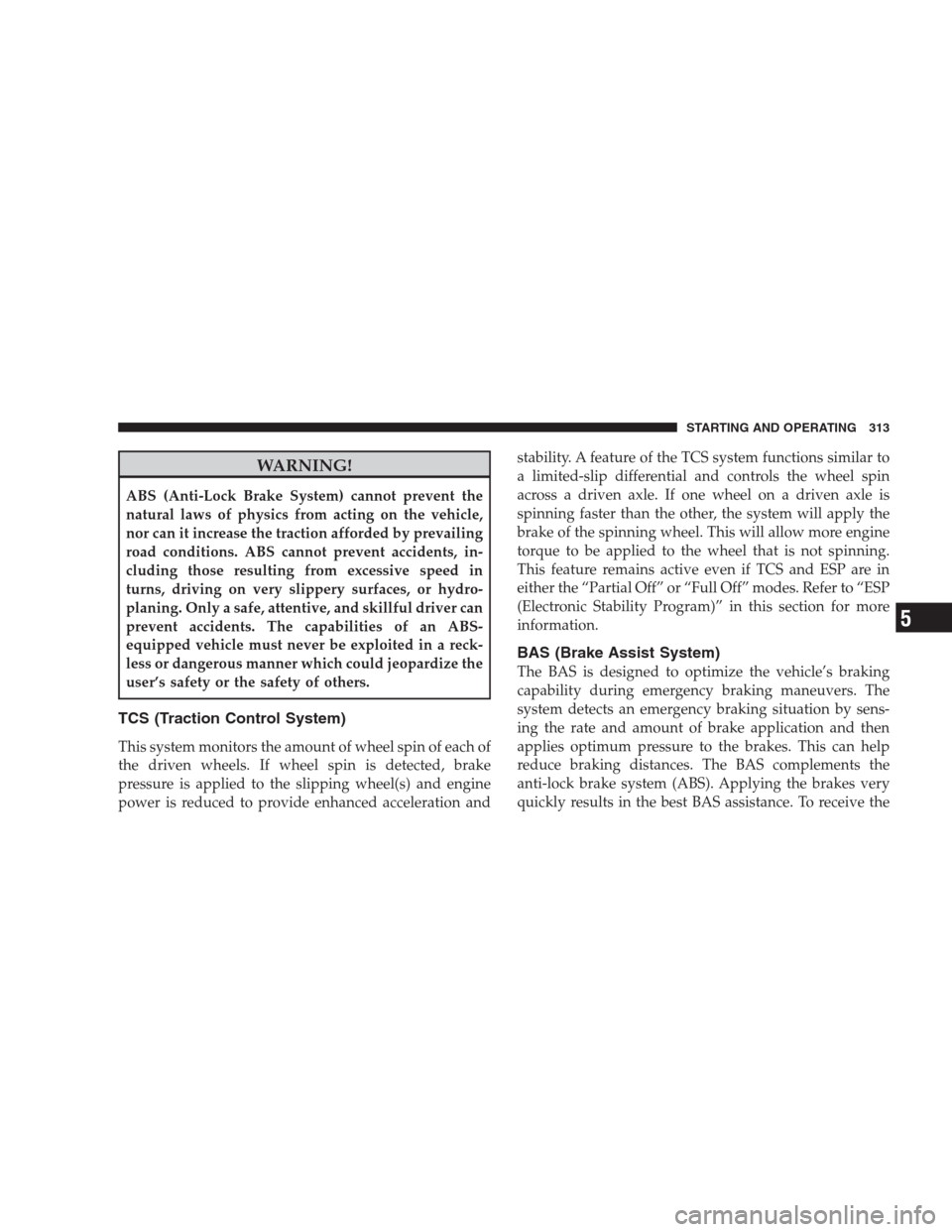
WARNING!
ABS (Anti-Lock Brake System) cannot prevent the
natural laws of physics from acting on the vehicle,
nor can it increase the traction afforded by prevailing
road conditions. ABS cannot prevent accidents, in-
cluding those resulting from excessive speed in
turns, driving on very slippery surfaces, or hydro-
planing. Only a safe, attentive, and skillful driver can
prevent accidents. The capabilities of an ABS-
equipped vehicle must never be exploited in a reck-
less or dangerous manner which could jeopardize the
user’s safety or the safety of others.
TCS (Traction Control System)
This system monitors the amount of wheel spin of each of
the driven wheels. If wheel spin is detected, brake
pressure is applied to the slipping wheel(s) and engine
power is reduced to provide enhanced acceleration andstability. A feature of the TCS system functions similar to
a limited-slip differential and controls the wheel spin
across a driven axle. If one wheel on a driven axle is
spinning faster than the other, the system will apply the
brake of the spinning wheel. This will allow more engine
torque to be applied to the wheel that is not spinning.
This feature remains active even if TCS and ESP are in
either the “Partial Off” or “Full Off” modes. Refer to “ESP
(Electronic Stability Program)” in this section for more
information.
BAS (Brake Assist System)
The BAS is designed to optimize the vehicle’s braking
capability during emergency braking maneuvers. The
system detects an emergency braking situation by sens-
ing the rate and amount of brake application and then
applies optimum pressure to the brakes. This can help
reduce braking distances. The BAS complements the
anti-lock brake system (ABS). Applying the brakes very
quickly results in the best BAS assistance. To receive the
STARTING AND OPERATING 313
5
Page 345 of 521
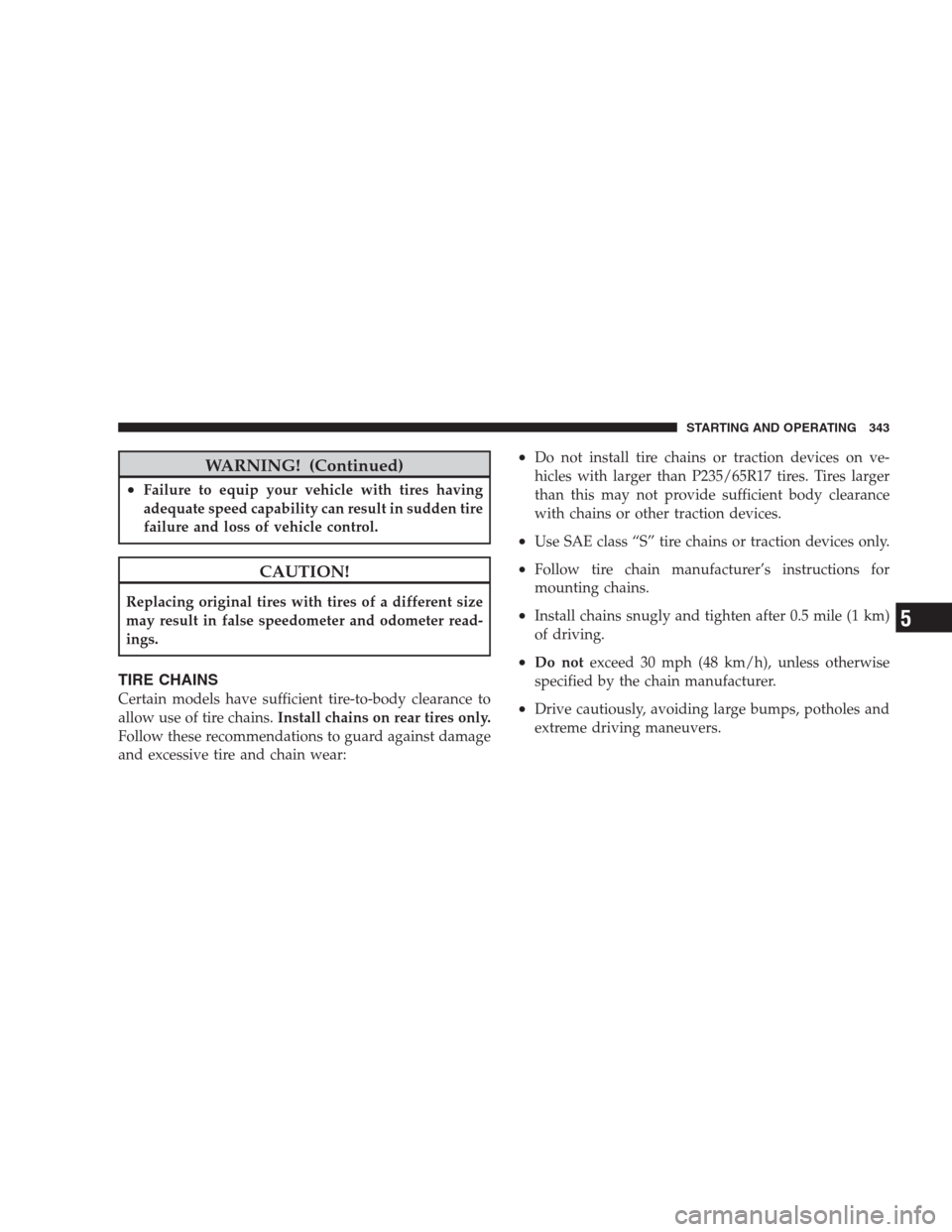
WARNING! (Continued)
•Failure to equip your vehicle with tires having
adequate speed capability can result in sudden tire
failure and loss of vehicle control.
CAUTION!
Replacing original tires with tires of a different size
may result in false speedometer and odometer read-
ings.
TIRE CHAINS
Certain models have sufficient tire-to-body clearance to
allow use of tire chains.Install chains on rear tires only.
Follow these recommendations to guard against damage
and excessive tire and chain wear:
•Do not install tire chains or traction devices on ve-
hicles with larger than P235/65R17 tires. Tires larger
than this may not provide sufficient body clearance
with chains or other traction devices.
•Use SAE class “S” tire chains or traction devices only.
•Follow tire chain manufacturer’s instructions for
mounting chains.
•Install chains snugly and tighten after 0.5 mile (1 km)
of driving.
•Do notexceed 30 mph (48 km/h), unless otherwise
specified by the chain manufacturer.
•Drive cautiously, avoiding large bumps, potholes and
extreme driving maneuvers.
STARTING AND OPERATING 343
5
Page 497 of 521
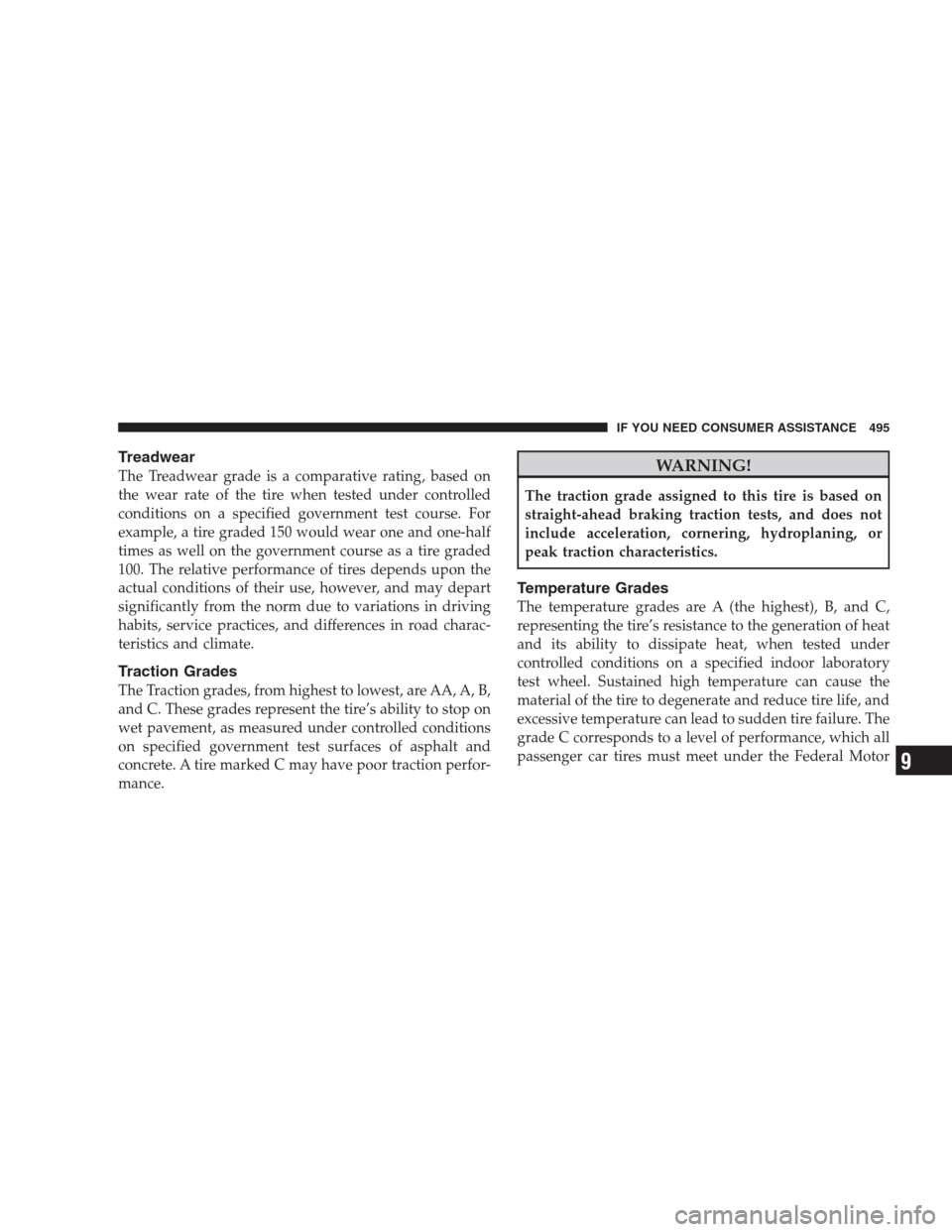
Treadwear
The Treadwear grade is a comparative rating, based on
the wear rate of the tire when tested under controlled
conditions on a specified government test course. For
example, a tire graded 150 would wear one and one-half
times as well on the government course as a tire graded
100. The relative performance of tires depends upon the
actual conditions of their use, however, and may depart
significantly from the norm due to variations in driving
habits, service practices, and differences in road charac-
teristics and climate.
Traction Grades
The Traction grades, from highest to lowest, are AA, A, B,
and C. These grades represent the tire’s ability to stop on
wet pavement, as measured under controlled conditions
on specified government test surfaces of asphalt and
concrete. A tire marked C may have poor traction perfor-
mance.
WARNING!
The traction grade assigned to this tire is based on
straight-ahead braking traction tests, and does not
include acceleration, cornering, hydroplaning, or
peak traction characteristics.
Temperature Grades
The temperature grades are A (the highest), B, and C,
representing the tire’s resistance to the generation of heat
and its ability to dissipate heat, when tested under
controlled conditions on a specified indoor laboratory
test wheel. Sustained high temperature can cause the
material of the tire to degenerate and reduce tire life, and
excessive temperature can lead to sudden tire failure. The
grade C corresponds to a level of performance, which all
passenger car tires must meet under the Federal Motor
IF YOU NEED CONSUMER ASSISTANCE 495
9
Page 504 of 521
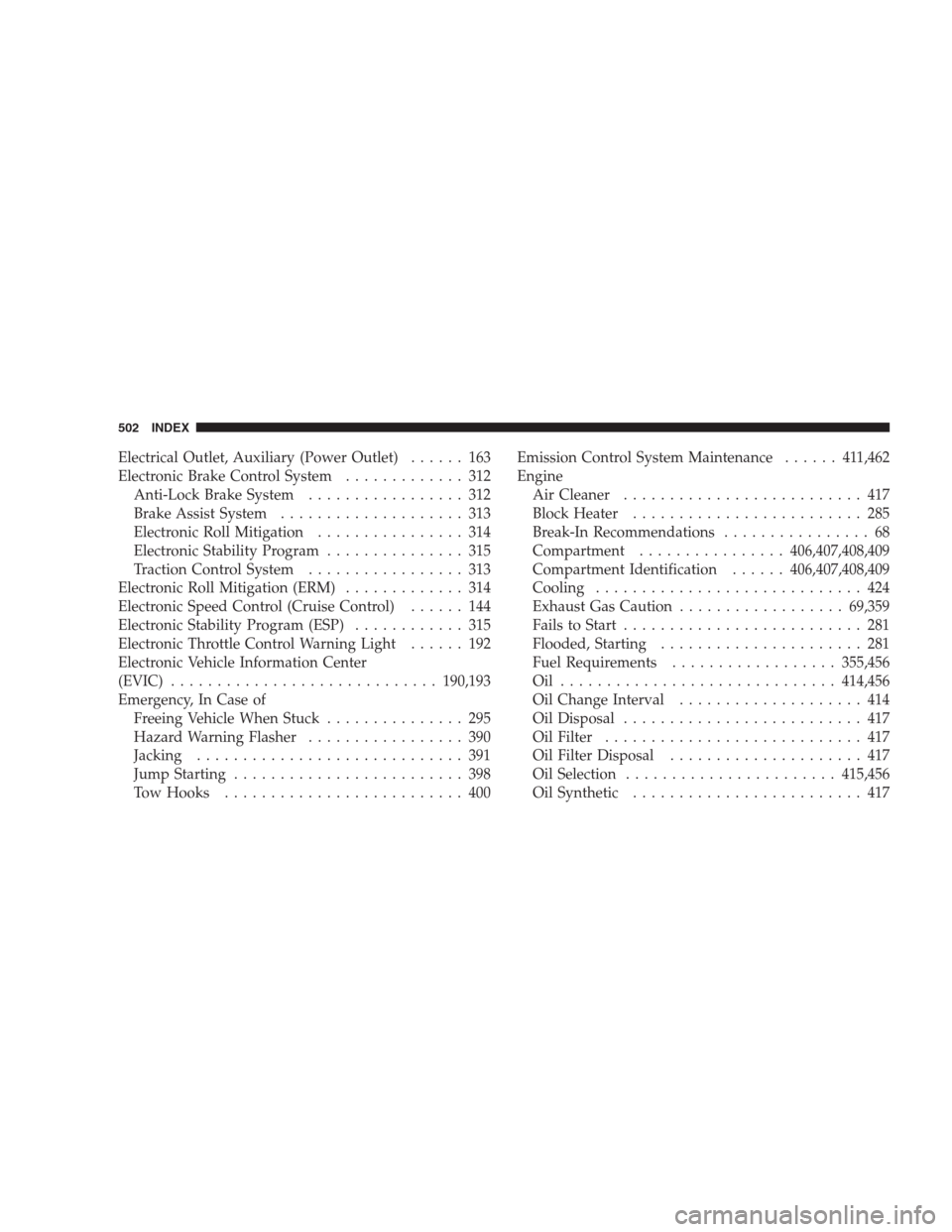
Electrical Outlet, Auxiliary (Power Outlet)...... 163
Electronic Brake Control System............. 312
Anti-Lock Brake System................. 312
Brake Assist System.................... 313
Electronic Roll Mitigation................ 314
Electronic Stability Program............... 315
Traction Control System................. 313
Electronic Roll Mitigation (ERM)............. 314
Electronic Speed Control (Cruise Control)...... 144
Electronic Stability Program (ESP)............ 315
Electronic Throttle Control Warning Light...... 192
Electronic Vehicle Information Center
(EVIC).............................190,193
Emergency, In Case of
Freeing Vehicle When Stuck............... 295
Hazard Warning Flasher................. 390
Jacking............................. 391
Jump Starting......................... 398
Tow Hooks.......................... 400Emission Control System Maintenance...... 411,462
Engine
Air Cleaner.......................... 417
Block Heater......................... 285
Break-In Recommendations................ 68
Compartment................406,407,408,409
Compartment Identification......406,407,408,409
Cooling............................. 424
Exhaust Gas Caution..................69,359
Fails to Start.......................... 281
Flooded, Starting...................... 281
Fuel Requirements..................355,456
Oil ..............................414,456
Oil Change Interval.................... 414
Oil Disposal.......................... 417
Oil Filter............................ 417
Oil Filter Disposal..................... 417
Oil Selection.......................415,456
Oil Synthetic......................... 417
502 INDEX
Page 510 of 521
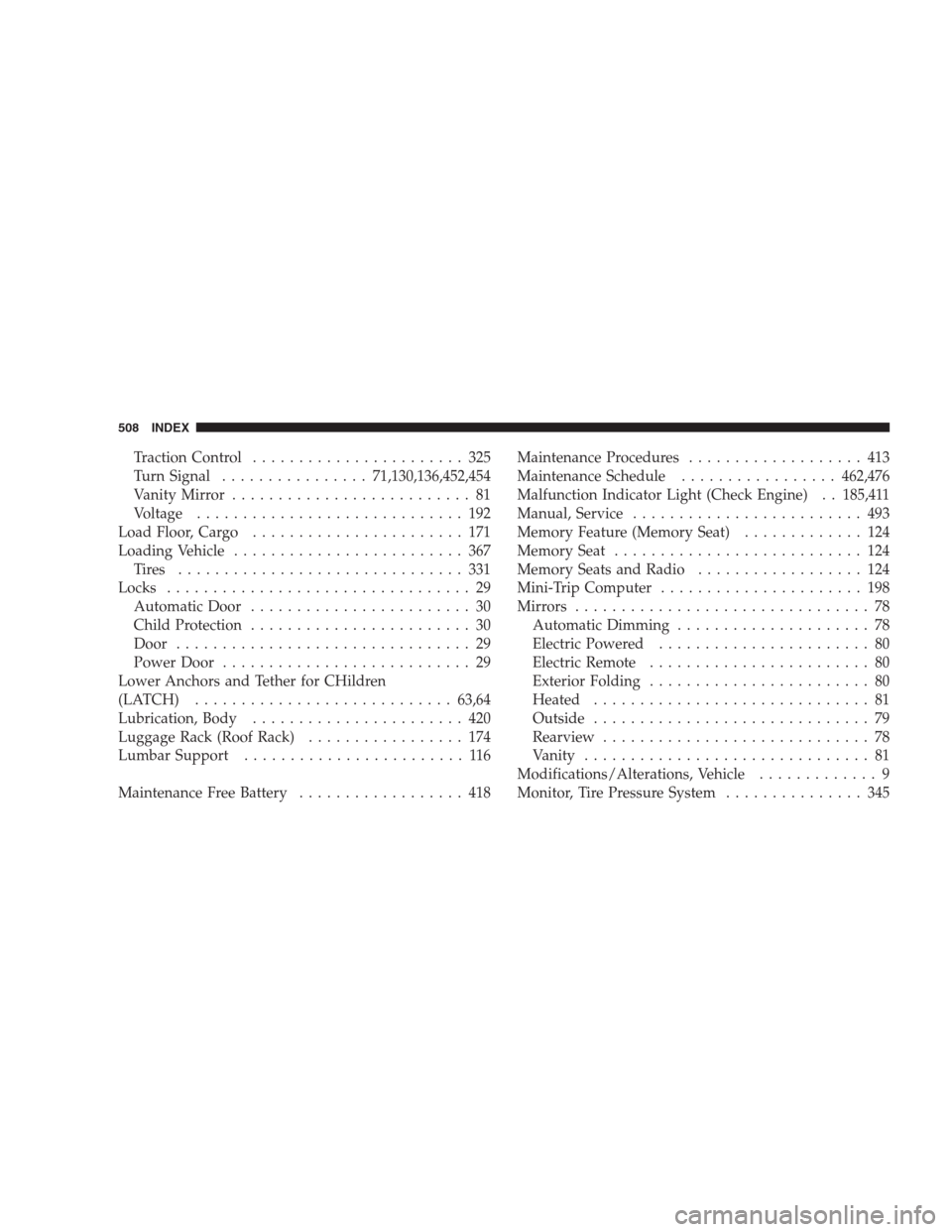
Traction Control....................... 325
Turn Signal................71,130,136,452,454
Vanity Mirror.......................... 81
Voltage............................. 192
Load Floor, Cargo....................... 171
Loading Vehicle......................... 367
Tires ............................... 331
Locks................................. 29
Automatic Door........................ 30
Child Protection........................ 30
Door................................ 29
Power Door........................... 29
Lower Anchors and Tether for CHildren
(LATCH)............................63,64
Lubrication, Body....................... 420
Luggage Rack (Roof Rack)................. 174
Lumbar Support........................ 116
Maintenance Free Battery.................. 418Maintenance Procedures................... 413
Maintenance Schedule.................462,476
Malfunction Indicator Light (Check Engine) . . 185,411
Manual, Service......................... 493
Memory Feature (Memory Seat)............. 124
Memory Seat........................... 124
Memory Seats and Radio.................. 124
Mini-Trip Computer...................... 198
Mirrors................................ 78
Automatic Dimming..................... 78
Electric Powered....................... 80
Electric Remote........................ 80
Exterior Folding........................ 80
Heated.............................. 81
Outside.............................. 79
Rearview............................. 78
Vanity............................... 81
Modifications/Alterations, Vehicle............. 9
Monitor, Tire Pressure System............... 345
508 INDEX